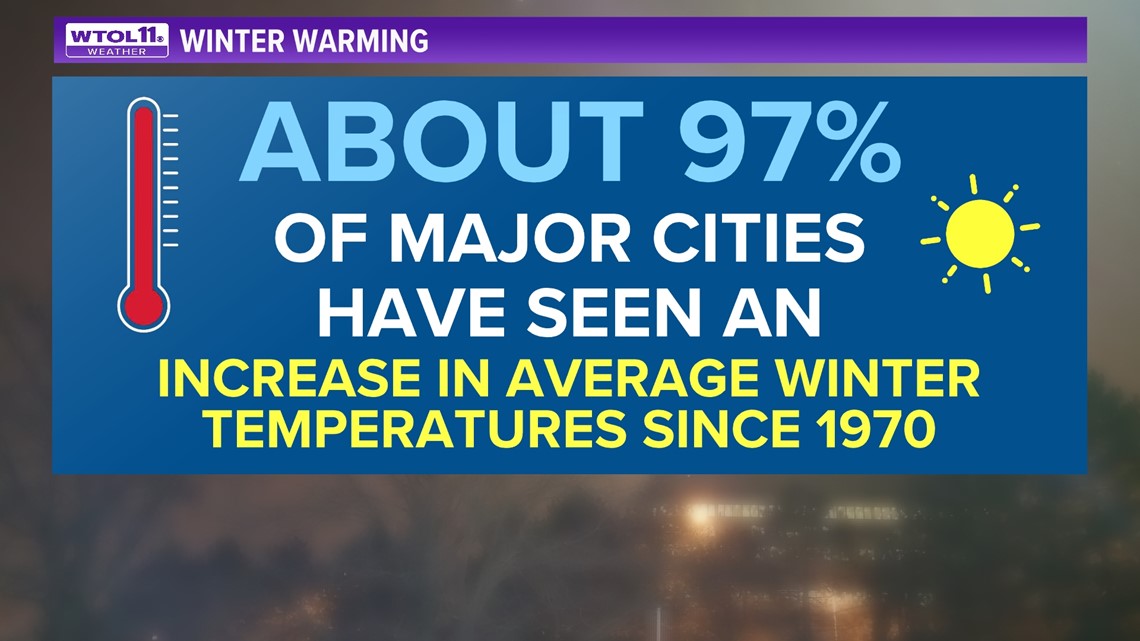TOLEDO, Ohio — Christmas is barely a week away, and you may be wondering about snow chances for the holiday weekend! White Christmas odds are on the rise, and the WTOL 11 weather team is forecasting increasing chances of Christmas snow.
Let's break down the snowfall potential for the holiday weekend and analyze the impacts of climate change on Christmas snow.
Christmas snow is by no means guaranteed in Ohio and Michigan, and historically, only 35% of years bring an inch or more of accumulation. That means that statistically, you'll only wake up to a blanket of Christmas snow one-third of the time.
This year, white Christmas chances are trending more likely than average, and the WTOL 11 weather team expects a 75% chance of Christmas snow as of the morning of Dec. 16.


As a colder, active weather pattern sets up for late December, snowy weather is growing likely for the holiday weekend. Snowfall is particularly likely late next week on Thursday, Dec. 22 into Friday, Dec. 23.
The WTOL 11 weather team has issued an Alert Day for next Friday due to the potential for snow-related travel impacts. The WTOL 11 weather team will keep a close eye on the potential for snow accumulation.
Let's look back on the past few Christmases.


Last year's Christmas was more green than white, featuring mild conditions and dry weather.
Christmas 2021 delivered a 1-inch blanket of Christmas snow, a nice holiday treat for snow lovers. 2022 could bring a coating of accumulation to make up for last year's unseasonable warmth.
As a whole, winter weather is growing warmer, in part due to climate change. Since 1970, Christmas in Toledo has grown 3.2 degrees warmer, a trend that has decreased the odds of Christmas snow.




The month of December as a whole has warmed up by a full 3 degrees in the last decade, warming by nearly 5 degrees since 1970. Warmer weather has led to an uptick in holiday rainfall and a decrease in Christmas snow.
An even more noticeable warming trend has been observed on the "twelve days of Christmas" from Dec. 25 through Jan. 5. Since 1970, this time frame has warmed up by a whopping 7.7 degrees. This drastic shift in climate normals has skewed holiday precipitation toward rain instead of snow.


Winter as a whole has warmed up by more than any season, and winter warming is the most pronounced across the eastern United States. 97% of major American cities have seen an increase in average winter temperatures since 1970.
While winter warming has been pronounced in the eastern United States, summer has warmed up by a greater amount out west. Due to global warming, winter weather, including Christmas, will become milder in the future. Even with climate change, cold weather will still strike, and frigid conditions are still possible.




The latter half of December will likely bring colder-than-normal conditions across much of the lower 48 states. The 10-day forecast features high temperatures largely in the 20s and 30s through the end of the year.
This year will likely bring a white Christmas, but Christmas snow is growing less common due to climate change.


Stay tuned to the WTOL 11 weather team for the latest on the holiday forecast and subscribe to next week's Climate Friday Newsletter!

